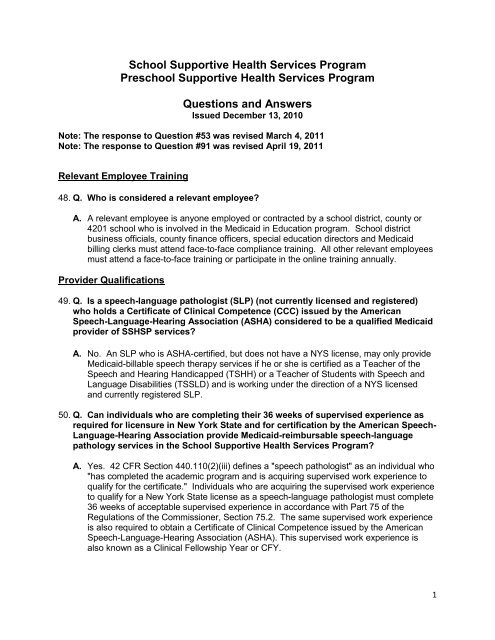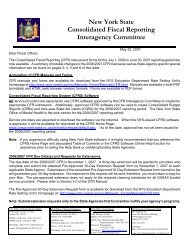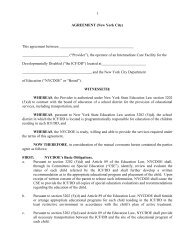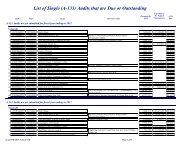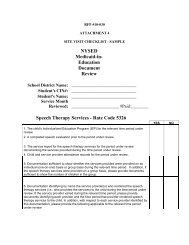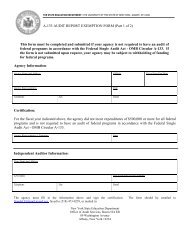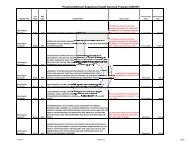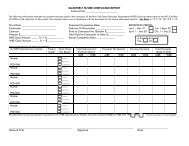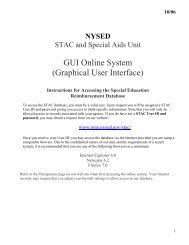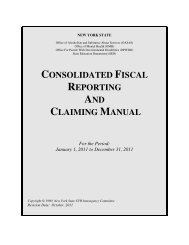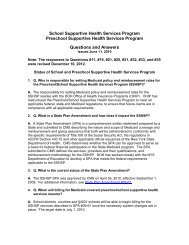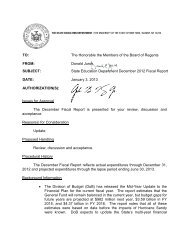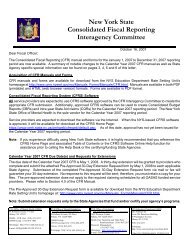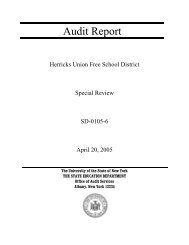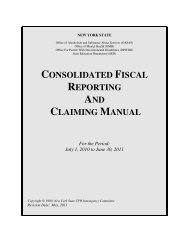School Supportive Health Services Program ... - Nassau BOCES
School Supportive Health Services Program ... - Nassau BOCES
School Supportive Health Services Program ... - Nassau BOCES
Create successful ePaper yourself
Turn your PDF publications into a flip-book with our unique Google optimized e-Paper software.
<strong>School</strong> <strong>Supportive</strong> <strong>Health</strong> <strong>Services</strong> <strong>Program</strong><br />
Preschool <strong>Supportive</strong> <strong>Health</strong> <strong>Services</strong> <strong>Program</strong><br />
Questions and Answers<br />
Issued December 13, 2010<br />
Note: The response to Question #53 was revised March 4, 2011<br />
Note: The response to Question #91 was revised April 19, 2011<br />
Relevant Employee Training<br />
48. Q. Who is considered a relevant employee?<br />
A. A relevant employee is anyone employed or contracted by a school district, county or<br />
4201 school who is involved in the Medicaid in Education program. <strong>School</strong> district<br />
business officials, county finance officers, special education directors and Medicaid<br />
billing clerks must attend face-to-face compliance training. All other relevant employees<br />
must attend a face-to-face training or participate in the online training annually.<br />
Provider Qualifications<br />
49. Q. Is a speech-language pathologist (SLP) (not currently licensed and registered)<br />
who holds a Certificate of Clinical Competence (CCC) issued by the American<br />
Speech-Language-Hearing Association (ASHA) considered to be a qualified Medicaid<br />
provider of SSHSP services?<br />
A. No. An SLP who is ASHA-certified, but does not have a NYS license, may only provide<br />
Medicaid-billable speech therapy services if he or she is certified as a Teacher of the<br />
Speech and Hearing Handicapped (TSHH) or a Teacher of Students with Speech and<br />
Language Disabilities (TSSLD) and is working under the direction of a NYS licensed<br />
and currently registered SLP.<br />
50. Q. Can individuals who are completing their 36 weeks of supervised experience as<br />
required for licensure in New York State and for certification by the American Speech-<br />
Language-Hearing Association provide Medicaid-reimbursable speech-language<br />
pathology services in the <strong>School</strong> <strong>Supportive</strong> <strong>Health</strong> <strong>Services</strong> <strong>Program</strong>?<br />
A. Yes. 42 CFR Section 440.110(2)(iii) defines a "speech pathologist" as an individual who<br />
"has completed the academic program and is acquiring supervised work experience to<br />
qualify for the certificate." Individuals who are acquiring the supervised work experience<br />
to qualify for a New York State license as a speech-language pathologist must complete<br />
36 weeks of acceptable supervised experience in accordance with Part 75 of the<br />
Regulations of the Commissioner, Section 75.2. The same supervised work experience<br />
is also required to obtain a Certificate of Clinical Competence issued by the American<br />
Speech-Language-Hearing Association (ASHA). This supervised work experience is<br />
also known as a Clinical Fellowship Year or CFY.<br />
1
An individual completing their supervised work experience (CFY) in speech-language<br />
pathology who is supervised by a New York State licensed speech-language pathologist<br />
may provide Medicaid-reimbursable speech-language pathology services in the <strong>School</strong><br />
<strong>Supportive</strong> <strong>Health</strong> <strong>Services</strong> <strong>Program</strong> as long as they have submitted the appropriate<br />
forms to the NYS Education Department identifying their supervisor and work setting and<br />
have received verification (Form 6) that their experience is approved. Please refer to the<br />
NYS Education Department's website at<br />
http://www.op.nysed.gov/prof/slpa/speechforms.htm for additional information.<br />
The intensity and type of supervision is left to the discretion of the supervising speechlanguage<br />
pathologist. For purposes of the <strong>School</strong> <strong>Supportive</strong> <strong>Health</strong> <strong>Services</strong> <strong>Program</strong>,<br />
the supervising licensed speech-language pathologist must co-sign the supervisee's<br />
evaluation reports and session notes. All "under the direction of" requirements outlined<br />
in SSHSP guidance at http://www.oms.nysed.gov/medicaid/q_and_a/ in Q&A # 20 must<br />
be followed. In addition, the school district, county, or Section 4201 school must<br />
maintain documentation identifying the licensed speech-language pathologist who<br />
provides supervision to the individual completing their 36 weeks of supervised<br />
experience and/or CFY, as well as the terms of supervision.<br />
51. Q. Is Medicaid reimbursement available for services provided by student interns?<br />
A. Medicaid reimbursement is available when individual or group therapy is being provided<br />
under the direct, face-to-face supervision of a New York State licensed and currently<br />
registered practitioner acting within his or her scope of practice. To be Medicaid<br />
reimbursable, a session involving a student intern must be conducted with the licensed<br />
clinician in continuous attendance with the student intern and the child or children<br />
receiving the service. In addition, the qualified practitioner must be guiding the student<br />
intern in service delivery and cannot be engaged in treating another child, supervising<br />
another student intern, or doing other tasks at the same time. The qualified practitioner<br />
is responsible for the services that are furnished to the child, including writing a session<br />
note that reflects the service that was delivered, and signing all documentation. It is<br />
permissible, but not necessary, for the student intern to sign the session note. A<br />
separate note may be written by the student intern for educational purposes. For further<br />
information please visit the CMS website:<br />
http://www.cms.gov/manuals/Downloads/bp102c15.pdf<br />
52. Q. The SPA does not include certified school psychologists within the list of qualified<br />
providers. Does this mean certified school psychologists may no longer conduct<br />
evaluations or provide services within the school setting?<br />
A. Refer to the SSHSP guidance document (Questions and Answers), pages 7-8 and<br />
Questions #22 and #23. The State Plan Amendment specifies which providers must<br />
provide psychological evaluations and psychological counseling services in order to be<br />
Medicaid reimbursable. <strong>Services</strong> provided by certified school psychologists are not<br />
reimbursable under Medicaid. Certified school psychologists may provide psychological<br />
counseling services/evaluations; however, psychological counseling<br />
services/evaluations provided by school psychologists cannot be billed to Medicaid.<br />
2
Note: The response to Question #53 was revised March 4, 2011. Deletions are<br />
struck through and additions are underlined.<br />
53. Q. Regarding PT services: New York’s licensure laws allow for “individual<br />
evaluation” of license applicants through which individuals not having graduated<br />
from a CAPTE-approved program may be granted a license. The SPA does not<br />
require CAPTE approval, although guidance documents seem to suggest the<br />
requirement. Please clarify. How will SED/DOH treat individuals holding a New York<br />
State license through the “individual evaluations” process?<br />
A. SPA #09-61 requires the physical therapist to be New York State licensed and<br />
registered as well as being qualified in accordance with 42 CFR 440.110 and with applicable<br />
state and federal laws and regulations. Per 42 CFR 440.110 a “qualified physical therapist”<br />
is an individual who is —<br />
(i) A graduate of a program of physical therapy approved by both the Committee on<br />
Allied <strong>Health</strong> Education and Accreditation of the American Medical Association and the<br />
American Physical Therapy Association or its equivalent; and<br />
(ii) Where applicable, licensed by the State.<br />
Individuals without the CAPTE accreditation need to go through the Department of<br />
Education Office of the Professions and apply for an equivalency determination on a<br />
case-by-case basis.<br />
Although the American Physical Therapy Association (APTA) does not directly approve<br />
any physical therapy education programs, CMS has determined that a CAPTE-approved<br />
program meets the regulation's credentialing requirement. The American Medical<br />
Association Committee no longer accredits physical therapy education programs. DOH<br />
is exploring the CAPTE requirement further. Additional information will be forthcoming.<br />
Individuals applying for New York State licensure who graduate from programs outside<br />
of the United States that are not accredited by the Commission on Accreditation in<br />
Physical Therapy Education (CAPTE) must apply to the New York State Education<br />
Department’s Office of Professions Comparative Education Unit for review of their<br />
education. Although a foreign-educated physical therapist may be licensed by New York<br />
State, CMS has determined that education equivalency rulings do not qualify physical<br />
therapists to bill for services provided under Medicaid. Therefore, at this time, only<br />
licensed physical therapists who have graduated from a CAPTE-approved program are<br />
qualified to provide services and be reimbursed by Medicaid.<br />
54. Q. Does Medicaid require that Occupational Therapist Assistants be registered with<br />
the National Board for Certification of Occupational Therapy (NBCOT)?<br />
A. No. Occupational Therapy Assistants do not need to be certified by the NBCOT for<br />
Medicaid reimbursement purposes. They must be certified by the NYS Commissioner of<br />
3
Education. Please see Medicaid Alert 10-2 posted on the Medicaid in Education website<br />
for additional information.<br />
55. Q. Does the equivalency determination from the NYS Attorney General apply to<br />
audiologists also?<br />
A. No, the equivalency determination does not apply to audiologists. Therefore,<br />
audiologists must have both a NYS license and current registration and the Certificate of<br />
Clinical Competence from the American Speech-Language-Hearing Association (ASHA)<br />
in order to bill Medicaid.<br />
Evaluations and <strong>Services</strong><br />
56. Q. Evaluations are part of the definition of occupational therapy (OT), physical<br />
therapy (PT) and speech therapy services, per the SPA 09-61. a) Are OT, PT and<br />
speech evaluations claimable? b) Do these evaluations need a written referral? c)<br />
Who are the professionals who can refer the child to each of these evaluations?<br />
A. a) Yes. OT, PT and speech evaluations are Medicaid reimbursable as long as there is<br />
documentation of the medical necessity and the evaluation is reflected in the IEP.<br />
b) Yes, these evaluations require a written order/referral prior to the evaluation.<br />
c) Refer to the "Provider Qualifications & Documentation Requirements” handout for<br />
information pertaining to who can order and furnish services. Please note that services<br />
include evaluations and ongoing treatment.<br />
57. Q. Is an evaluation that doesn’t result in a recommendation for additional services<br />
Medicaid reimbursable if the student already has an Individualized Education<br />
<strong>Program</strong> (IEP) and is receiving other SSHSP services?<br />
A. Yes, as long as it is ordered properly, included in the IEP, conducted by a Medicaid<br />
approved provider, and documented properly.<br />
58. Q. Who is the “appropriate school official” who may refer a student for psychological<br />
counseling services?<br />
A. An appropriate school official or other official means any teacher, administrative<br />
personnel, Committee on Special Education (CSE)/Committee on Preschool Special<br />
Education (CPSE) chairperson or member, or other professional who is familiar with the<br />
needs of the individual student.<br />
59. Q. Does the Individualized Education <strong>Program</strong> (IEP) establish medical necessity?<br />
A. No. According to 20 U.S.C. §1401(26)(A), related services are “designed to enable a<br />
child with a disability to receive a free appropriate public education” or “to benefit from<br />
special education.” SSHSP services are a subset of IDEA-defined related services. The<br />
IEP determines which related services are needed to facilitate the student’s educational<br />
progress. It does not constitute medical necessity.<br />
4
The written orders or written referrals that are in the student’s record document medical<br />
necessity. See the “Training on Compliance Agreement, Written Compliance Policies<br />
and <strong>Program</strong> Update” PowerPoint posted on the Medicaid-In-Education website. In<br />
addition, refer to SSHSP Questions and Answers #32 for the required elements of a<br />
written order.<br />
Skilled Nursing <strong>Services</strong><br />
Note: The responses to questions 60 through 70 were developed in conjunction with the Office<br />
of Student Support <strong>Services</strong> of the New York State Education Department.<br />
60. Q. What are the different roles of an RN and an LPN?<br />
A. Per Section 6902 of Article 139 of the Education Law, a Registered Nurse (RN) is<br />
defined as being qualified to diagnose and treat human responses to actual or potential<br />
health problems through such services as casefinding, health teaching, health<br />
counseling, and provision of care supportive to or restorative of life and well-being, and<br />
executing medical regimens prescribed by a licensed physician, dentist or other licensed<br />
health care provider legally authorized under this title and in accordance with the<br />
commissioner’s regulations. A nursing regimen shall be consistent with and shall not<br />
vary any existing medical regimen.<br />
Per Section 6902 of Article 139 of the Education Law a Licensed Practical Nurse (LPN)<br />
is defined as being qualified to perform tasks and responsibilities within the framework of<br />
casefinding, health teaching, health counseling, and provision of supportive and<br />
restorative care under the direction of a registered professional nurse or licensed<br />
physician, dentist, or other licensed health care provider legally authorized under this<br />
title and in accordance with the commissioner’s regulations.<br />
For further information see http://www.op.nysed.gov/prof/nurse/article139.htm<br />
An LPN cannot assess or triage, and therefore would not be able to document progress<br />
towards a goal(s). LPNs perform designated tasks, and report any data they collect to<br />
the RN for interpretation.<br />
61. Q. Is it the responsibility of the school nurse (RN) to supervise an LPN working in the<br />
same school?<br />
A. Per Section 6902 of Article 139 an LPN must practice within their scope of practice<br />
“under the direction of a registered professional nurse, licensed physician, dentist or<br />
other licensed provider legally authorized under this title”... the RN, school nurse, in the<br />
building is not responsible to supervise the LPN unless that is in her job description;<br />
however he/she would be responsible for the provision of direction to the LPN and<br />
overseeing the quality of care the students receive. The district is responsible for<br />
providing supervision to both district employees and independent contractors or agency<br />
nurses that they pay to work in the district. The medical director, school nurse if there is<br />
one, and the board of education are responsible for insuring the students receive the<br />
appropriate care.<br />
5
62. Q. Must the Registered Nurse co-sign the Licensed Practical Nurse’s signature for<br />
every Medication Administration Record in order for the service to be Medicaid<br />
reimbursable?<br />
A. No. The RN does not need to co-sign an LPN's signature in order for the service to be<br />
Medicaid reimbursable.<br />
63. Q. Since an LPN is assigned a National Provider Identifier (NPI) number for<br />
reimbursement by Medicaid as an independent practitioner, does that mean LPNs are<br />
able to function as independent practitioners?<br />
A. No. An LPN’s scope of practice is defined in Education Law §6902(2). The scope of<br />
practice states that the LPN is to work under the direction of a registered professional<br />
nurse or licensed physician, dentist or other licensed health care provider designated in<br />
the Education Law or the Commissioner’s regulations.<br />
64. Q. What documentation is needed to support Medicaid reimbursement for skilled<br />
nursing services?<br />
A. In addition to documentation required for any Medicaid-covered service (e.g., written<br />
orders), session notes and/or Medication Administration Records are also needed to support<br />
Medicaid reimbursement for skilled nursing services. See Table 1 for clarification.<br />
Table 1. Documentation Requirements for Skilled Nursing <strong>Services</strong><br />
SKILLED NURSING SERVICE<br />
<strong>Health</strong> assessments and evaluations,<br />
including necessary consultation with<br />
licensed physicians, parents and/or<br />
staff regarding health care of student<br />
Medical treatments and procedures,<br />
including necessary consultation with<br />
licensed physicians, parents and/or<br />
staff regarding health care of student<br />
Administration of medication<br />
SESSION NOTE<br />
X<br />
X<br />
MEDICATION<br />
ADMINISTRATION<br />
RECORD (MAR)<br />
X<br />
Session notes<br />
The required elements of a session note may be found in Questions and Answers issued<br />
June 11, 2010 (# 25) on the Medicaid-in-Education home page at<br />
http://www.oms.nysed.gov/medicaid<br />
65. Q. What information must be included in a Medication Administration Record (MAR)?<br />
6
A. The medication log (MAR) must include:<br />
• Student’s name and date of birth<br />
• Grade/<strong>School</strong><br />
• Medication name, dosage, and route<br />
• Order start date<br />
• Order expiration date<br />
• Prescriber’s name/telephone number<br />
• Parent’s name/telephone number<br />
• Date, time, and dosage of medication administered<br />
• Signature and title of the person administering medication<br />
<strong>School</strong> nursing personnel should maintain accurate records of the medication<br />
administered, any special circumstances related to the procedure, and the student’s<br />
reactions/responses.<br />
A sample Medication Administration Record (MAR) is available at:<br />
http://www.schoolhealthservicesny.com/a-zindex.cfm?subpage=33<br />
66. Q. May initials be used on the medication log (MAR) instead of the full signature?<br />
A. No. A full original signature is required by Medicaid in order to positively identify the<br />
licensee. Stamped signatures are not permitted on health care provider orders or school<br />
health documentation.<br />
67. Q. Can the regularly employed <strong>School</strong> Nurse sign off on the Monthly Service Forms<br />
that a procedure/medication was done by a substitute <strong>School</strong> Nurse (documented on<br />
medication administration form)?<br />
A. For purposes of Medicaid reimbursement, a monthly sign off is not necessary. Medicaid<br />
requires that the medication administration form be signed by the administering nurse at<br />
the time the service is rendered. It is recommended that a note is written periodically in<br />
the cumulative health record to summarize.<br />
68. Q. Where can I find additional information on medication administration in the school<br />
setting?<br />
A. The Education Department’s Administration of Medication in the <strong>School</strong> Setting<br />
Guidelines is available at<br />
http://www.schoolhealthservicesny.com/uploads/AdminMed.pdf. Additional questions<br />
may be directed to the Office of Student Support <strong>Services</strong> at 518-486-6090.<br />
69. Q. In the questions and answers document issued 6/11/2010 under number 34 A(b), it<br />
indicates that orders need to be written within a given "school year." Within the<br />
document from SED "Administration of Medication in <strong>School</strong>s 2002" the procedure<br />
indicates that orders need to be written "annually" or "when there is a change in<br />
medication." This time frame does not necessarily coincide with the July 1 - June 30<br />
"school year." Can we continue with what we have always done in renewing on an<br />
annual basis?<br />
7
A. Medication orders are valid for 12 months unless otherwise specified. For ease of<br />
documentation and tracking, orders for nursing services for a school year are<br />
recommended to start on or after 9/1 and end on 8/31 of the following year. Order<br />
changes would need to be dated as they occur. Unless the student will be attending<br />
summer school, parents/guardians should pick up medications at the end of the school<br />
year.<br />
70. Q. I am still not clear on the "up to 15 minute" billing time and what that includes. Is<br />
it just the actual face to face, skilled nursing time or does this time include the<br />
student coming to the office; travel time if the nurse is travelling between school<br />
buildings; paperwork; etc.?...<br />
A. Only face-to-face time in skilled nursing services is Medicaid reimbursable.<br />
Special Transportation<br />
71. Q. Is transportation to another school district building alone a billable transportation<br />
service?<br />
A. No. Medicaid reimbursement for special transportation is only available when a student<br />
is being transported to or from a Medicaid reimbursable service. In addition, special<br />
transportation must be included in the IEP and all other documentation requirements<br />
must be met. For more information on special transportation including documentation<br />
requirements, see #43 - #45 of the Questions and Answers posted on the Medicaid-In-<br />
Education website.<br />
72. Q. When completing the transportation log, is the full address, including street, city,<br />
and state needed for each trip or can they just include "home" and "school"?<br />
A. The full address of each origination and destination must be documented; however, this<br />
does not necessarily have to be recorded on each daily transportation log. For example,<br />
in a situation when routine special transportation services are provided from the<br />
student’s home to the school it is sufficient to use the terms ‘home’ and ‘school’ on the<br />
daily log and to document the full street addresses separately in the student’s record.<br />
The transportation log must include the following elements for each trip:<br />
• The student’s name;<br />
• Both the origination of the trip and time of pickup*;<br />
• Both the destination of the trip and time of drop off*;<br />
• Bus number or the vehicle license plate number; and,<br />
• The full printed name of the driver providing the transportation.<br />
For more information see the SSHSP Questions and Answers document (#43 - #45)<br />
posted on the Medicaid in Education website.<br />
*See question #73 for additional clarification.<br />
8
73. Q. a) Must the special transportation provider document the pickup and drop off time<br />
of each student on the bus when completing a daily transportation log? b) Does<br />
every Medicaid eligible student need their own daily transportation log?<br />
A. a) This response is specific to the requirement to document pickup and drop off times<br />
referenced in question #72. It is acceptable for the transportation log to indicate the<br />
actual time the first student was picked up and the actual time the last student was<br />
dropped off. For example, when the same bus is transporting the same students from<br />
their homes to the school in the morning the transportation log could indicate the time<br />
and place the first student is picked up and the time and place all the students are<br />
dropped off. The bus manifest and/or schedule may serve as documentation of the<br />
pickup locations and times in between the first pick up and the last drop off.<br />
b) No. It is not necessary for the provider to create a separate special transportation log<br />
for each Medicaid eligible student.<br />
Sessions (Individual, Group, Make-up, Frequency)<br />
74. Q. Are integrated (push-in) speech therapy services reimbursable by Medicaid? If a<br />
speech-language pathologist (SLP) goes into the classroom acting as a teacher aide;<br />
and in the course of instruction sits with various students or groups of students and<br />
makes sure to periodically include the student(s) that is receiving SSHSP services,<br />
can the SLP bill for these services? Often it will be in five-minute increments in the<br />
course of an hour spent in the classroom, possibly totaling 15 minutes. Can the<br />
minutes be totaled and billed as either group or individual as appropriate?<br />
A. Therapy provided in this setting may only be billed to Medicaid if the servicing provider<br />
can document the occurrence of appropriate one-on-one or group (sized up to five<br />
students*) services provided and meet all other Medicaid billing documentation<br />
requirements. Classroom instruction is not a Medicaid reimbursable service, regardless<br />
of the amount of time spent instructing the Medicaid eligible student. The services of a<br />
teacher aide are not Medicaid reimbursable.<br />
*Larger group sizes are permissible in NYC. Refer to Question #76.<br />
75. Q. If the IEP only states group therapy, but both individual and group services were<br />
provided, what can the school district, county or §4201 school bill for?<br />
A. You may only bill for ordered services that are included on the IEP. If only group therapy<br />
is indicated on the IEP, then Medicaid reimbursement is only available for group therapy.<br />
An example would be when a group of four students is scheduled, but only one student<br />
shows up. Because a group is defined for reimbursement purposes as two or more, you<br />
may not bill this as group. Since this student’s IEP only states group, you may not bill for<br />
the individual session either because it is not in the IEP.<br />
76. Q. Is there a limit on how many students can be in a group for related services (e.g.,<br />
speech therapy, occupational therapy, physical therapy)?<br />
A. Part 200.6(e)(3) of the regulations of the Commissioner of Education states “When a<br />
related service is provided to a number of students at the same time, the number of<br />
students in the group shall not exceed five students per teacher or specialist, except<br />
9
that, in the city school district of the city of New York, the commissioner shall allow a<br />
variance of up to 50 percent rounded up to the nearest whole number from the maximum<br />
of five students per teacher or specialist.”<br />
The ratio of 5:1 for speech group therapy sessions is allowed per Part 200.6(e)(3) of the<br />
regulations of the Commissioner of Education. This ratio is also allowable for Medicaid<br />
billing purposes. Medicaid reimbursement is available for group therapy sessions<br />
involving two or more students.<br />
77. Q. Is Medicaid reimbursement available for therapy sessions that have to be madeup?<br />
A. In order for a make-up therapy session to be Medicaid reimbursable it must be<br />
consistent with the written order/referral (medically necessary) and must:<br />
• Be a service that is documented in the IEP<br />
• Occur within the week within which the missed visit occurred<br />
• Be documented (session notes must be kept for each session including made up<br />
sessions)<br />
• Be provided by a qualified Medicaid provider<br />
• Fit with the desired treatment outcome<br />
Example:<br />
The written order and the IEP specify three 30-minute physical therapy sessions per<br />
week must be provided. The student misses one session due to absence from school.<br />
If the session is made-up within the same week Medicaid can be billed for all three<br />
sessions because only the three sessions have been provided within one week. If the<br />
missed session is provided in a subsequent week Medicaid can only be billed for three<br />
of the four sessions provided that week because the IEP specified three therapy<br />
sessions per week, not four.<br />
78. Q. Can more than one therapist providing co-treatment bill for the same session?<br />
A. Co-treatment consists of more than one professional providing treatment at the same<br />
time. Therapists, or therapy assistants, working together as a “team” to treat one or<br />
more individuals cannot bill separately for the same or different service provided at the<br />
same time to the same individual. For co-treatments only one Current Procedural<br />
Terminology (CPT) code may be billed per session (untimed CPT codes) or per unit<br />
(timed CPT codes).<br />
Where a physical and an occupational therapist (timed CPT code) both provide services<br />
to one individual at the same time, either one therapist can bill for the entire service or<br />
the PT and OT can divide the service units if applicable. If services are provided by a<br />
speech-language pathologist (untimed CPT code) and an occupational or physical<br />
therapist (timed CPT code), only one discipline per session may be billed. The session<br />
note should reflect the service provided by each practitioner during the session.<br />
79. Q. Many IEPs did not/do not list “psychological counseling”; but, rather, indicate<br />
“counseling” without modifier; or “social work”; or “family training.” Must all IEPs<br />
10
now describe those services as “psychological counseling”? How will IEPs<br />
implemented on and after 9/1/09 to the present be managed?<br />
A. Effective 9/1/2009, in order for psychological counseling services to be Medicaid<br />
reimbursable, "psychological counseling" must be listed on the IEP. The service<br />
provided must meet the definition of psychological counseling services included in SPA<br />
#09-61 ("treatment services using a variety of techniques to assist the child in<br />
ameliorating behavioral and emotional problems that are severe enough to require<br />
treatment."). In addition, services must be medically necessary, provided by a qualified<br />
provider and fully documented. For more information on provider qualifications and<br />
documentation requirements, see the Questions and Answers (issued June 11, 2010)<br />
posted on the Medicaid in Education website.<br />
80. Q. How should a “consultation” between clinical and/or instructional staff be<br />
documented? Are “consultations” Medicaid reimbursed?<br />
A. A consultation between clinical and/or instructional staff should be documented as the<br />
professional/clinician sees fit. Consultations between/among professionals are not<br />
Medicaid reimbursed under SSHSP.<br />
81. Q. Are there any SSHSP services Medicaid will reimburse if the student is not<br />
present?<br />
A. Medicaid will not reimburse any SSHSP service when the student is not present.<br />
Activities associated with service delivery, such as writing evaluation reports or session<br />
notes, meeting with family members, or consulting with teachers or other professionals<br />
are not separately Medicaid reimbursable.<br />
Documentation<br />
82. Q. Can providers use a signature stamp rather than manually signing each day’s<br />
session notes?<br />
A. The use of a signature stamp is not acceptable.<br />
Provider Credentials<br />
83. Q. What documentation is acceptable proof of provider credentials for independent<br />
contractors? Is checking licensure on NYS Education Department’s (SED) Office of<br />
the Professions website sufficient? Must the school districts, counties and §4201<br />
schools have copies of each license for all “agency service providers” that they<br />
contract with?<br />
A. Documentation of provider credentials is the responsibility of the school districts,<br />
counties and §4201 schools. There are several ways to check provider credentials.<br />
<strong>School</strong> districts, counties and §4201 schools should have a copy of each provider’s<br />
11
credentials on file and must only bill Medicaid for services provided by qualified<br />
practitioners.<br />
Districts/counties may be able to verify a provider’s license using the NYS Office of the<br />
Professions website at http://www.op.nysed.gov/opsearches.htm. It may also be<br />
necessary to verify the educational background, including the program from which an<br />
individual graduated, in some instances.<br />
84. Q. Should there be multiple copies of a provider’s license and registration<br />
maintained—for example, one with the Committee on Special Education and one with<br />
the Business office?<br />
A. Maintaining multiple copies of a provider’s license and registration is not necessary.<br />
85. Q. Should school districts, counties and §4201 schools check licensure and<br />
registration yearly?<br />
A. Yes. It is the responsibility of the school districts, counties and §4201 schools to verify<br />
NYS licensure and current registration at least on an annual basis. In addition, school<br />
districts and counties are responsible for checking the Federal and State exclusion lists.<br />
Exclusion Lists<br />
86. Q. As a school district, county or §4201 school, are we required to check the<br />
exclusion status of any practitioner who prescribes or orders a service (e.g., physical<br />
therapy, occupational therapy, or speech therapy) that will be billed to Medicaid?<br />
A. Yes. A person who is excluded from Medicaid cannot be involved in any activity relating<br />
to furnishing care, services, or supplies for which claims are submitted, or relating to<br />
claiming or receiving payment for medical care service or supplies.<br />
87. Q. Should school districts, counties, or §4201 schools check the exclusion lists for<br />
all employees of an agency with multiple contracts and services, or only those<br />
employees who work in programs involved in Medicaid/Medicare billing?<br />
A. The billing provider should verify that all employees, contractors or service providers<br />
who are involved in generating a claim to bill for services or being paid by Medicaid<br />
(including if their salaries are included on a cost report submitted to the Medicaid<br />
program) are not on the excluded list.<br />
88. Q. Exclusion list checking – per OMIG compliance, we need to be checking the<br />
providers through three different websites for exclusion from the Medicaid/Federal<br />
programs. The compliance certifications didn't start until 12/31/09. Most counties are<br />
just beginning to do these checks, so would checking the websites now allow us to<br />
bill for services provided in September 2009 through June 2010?<br />
A. Providers have always been required to check the PVR-292 (the list of excluded,<br />
restricted and terminated providers) when submitting a claim to Medicaid in order to<br />
ensure excluded individuals and entities do not participate in the Medicaid program. This<br />
check should be done before a claim is submitted.<br />
12
89. Q. Does every employee who works at the school district, county or §4201 school<br />
need to be checked? Even non-medical personnel such as bus drivers and<br />
transportation company owners?<br />
A. A person who is excluded from Medicaid cannot be involved in any activity relating to<br />
furnishing care, services, or supplies for which claims are submitted, or relating to<br />
claiming or receiving payment for medical care service or supplies.<br />
A provider should check the PVR-292 for any employee whose responsibilities could<br />
cause a claim to be made. When a provider uses a subcontractor to provide a service for<br />
which a claim would be submitted, we recommend the provider include language in the<br />
contract with subcontractor which would require the subcontractor to check PVR-292<br />
against the names of his employees whose responsibilities could result in a Medicaid<br />
claim.<br />
90. Q. How often must providers be checked?<br />
A. The OMIG recommends the PVR-292 (the list of excluded, restricted and terminated<br />
providers) be checked every 30 days.<br />
Written Orders and Referrals<br />
Note: The response to Question #91 was revised April 19, 2011. Deletions are struck<br />
through and additions are underlined.<br />
91. Q. Can school districts accept prescriptions for occupational therapy (OT), physical<br />
therapy (PT), speech therapy, and/or skilled nursing services from physicians, nurse<br />
practitioners or physician assistants who are located in a border state, but not<br />
registered with the New York State Office of the Professions?<br />
A. Yes. Out-of-state practitioners (physician/physician assistant, nurse practitioner) who<br />
are licensed by the appropriate state agency in which they are located may prescribe<br />
medically necessary care/treatment for NYS Medicaid recipients.<br />
In accordance with Article 31 section §6526 of the State Education Law, the only out-ofstate<br />
practitioners that may prescribe medically necessary care/treatment are physicians<br />
licensed in a bordering state and who reside near the border of this state. The border<br />
vicinity is usually defined as less than 25 miles.<br />
92. Q. If there is a change made to an IEP (service change) then is a new referral or order<br />
that covers that service type required?<br />
A. Yes. A written order/referral must be completed for each additional type of service, or<br />
change to an existing service, to be Medicaid reimbursable.<br />
93. Q. Can a doctor write and sign one script for several students, or would a script be<br />
needed for each student?<br />
A. No, this is not permissible; a separate order/referral is required for each student to<br />
protect each student’s confidentiality.<br />
13
94. Q. Can a NYS licensed and currently registered speech-language pathologist (SLP)<br />
who has not seen the student write a referral for speech therapy?<br />
A. No. The SLP cannot write a referral if they have not seen the student. 18 NYCRR<br />
505.11 states that a written order must contain a diagnostic statement and purpose of<br />
treatment. It is not acceptable under the Medicaid program for the ordering or referring<br />
professional never to have met with the child as it is incompatible with the obligations of<br />
the ordering practitioner to assure that the ordered care, services, or supplies will meet<br />
the recipient's needs and restore him or her to the best possible functional level.<br />
95. Q. Can the old prescriptions received for 2009-2010 services, some of which may be<br />
12-15 months old by this time, be returned to the physician with a request to annotate<br />
them to include the diagnosis code or treatment purpose without affecting the validity<br />
of the original prescription?<br />
A. No, an original prescription cannot be altered.<br />
96. Q. Can a statement signed and dated by the physician now, indicating the diagnosis<br />
or purpose of the treatment which was prescribed for the 2009-2010 school year on,<br />
for example 7/1/2009, be used as a supplement to the original prescription, allowing it<br />
to be used to meet the new prescription (written order/referral) requirements?<br />
A. No, written orders for services must be prospective.<br />
97. Q. What would a referral for Psychological Counseling consist of? Would it be an<br />
annual requirement or one referral at the start of counseling?<br />
A. For clarification on “referral” for Psychological Counseling refer to the Provider<br />
Qualifications and Documentation Requirements available on the Medicaid in Education<br />
website. Referrals for psychological counseling services may be made by an<br />
appropriate school official, such as a school administrator or the chairperson of the<br />
CSE/CPSE, or a licensed practitioner acting within his/her scope of practice. Referrals<br />
should coincide with the time frame reflected in the IEP. A copy of the referral should be<br />
included in the student’s record.<br />
98. Q. Are ICD-9 diagnosis codes required on written orders/referrals?<br />
A. Diagnosis codes (ICD-9 codes) are not currently a NYS requirement on written orders or<br />
referrals for SSHSP, however, they may be included if available. The items that must be<br />
included in a written order/referral are listed in the SSHSP Questions and Answers (see<br />
question #32). In the future, ICD-9 codes will be required when submitting claims to<br />
Medicaid for reimbursement. A Medicaid Alert will be issued and posted on the<br />
Medicaid in Education website prior to instituting this requirement.<br />
Session Notes<br />
99. Q. What specific information is to be included in a “session note”? Do session notes<br />
only reflect start/end times of the face-to-face service; or (a) Are session notes to<br />
reflect the service as provided, or as set out in the IEP (for example, the IEP requires<br />
a group session, but 2 of the 3 group are absent, effectively resulting in an “individual<br />
session”)? (b) Is the “session” direct contact time only, or does it presume record<br />
14
keeping time within that “session”? If record keeping is not included within the<br />
“session,” how is that activity to be documented and is it a “Medicaid” service?<br />
A. The specific elements of a session note are included in guidance (SSHSP Questions<br />
and Answers) posted on the State Education Department’s Medicaid in Education web<br />
page. Please refer to Session Notes and Progress Notes handout posted on the<br />
Medicaid in Education website.<br />
(a) Session notes should reflect the service that was actually delivered. See Question<br />
#75 for guidance on billing for group versus individual sessions.<br />
(b) The session is direct contact time. There is no separate reimbursement for record<br />
keeping.<br />
100. Q. What is the suggested time frame for completing contemporaneous session<br />
notes?<br />
A. “Contemporaneous” means occurring at or about the same period of time. Sessions<br />
should be documented as close to the conclusion of the session as practicable.<br />
101. Q. a) Do Session Notes have to include a CPT Code(s)? Are these then forwarded<br />
to the billing clerk? b) Is there a prescribed form that should be used—is it<br />
possible for school districts, counties and §4201 schools to make their own?<br />
A. a) Session Notes do not have to include a CPT Code(s). The content of the note<br />
should support the CPT code or codes billed for the session. The specific place you<br />
record the CPT code(s) is at the discretion of the school district, county, or §4201<br />
school in which you provide services. Yes, the CPT codes selected by the servicing<br />
provider need to be communicated to the billing clerk.<br />
b) There is no prescribed format for session notes; required elements are listed in<br />
<strong>School</strong> <strong>Supportive</strong> <strong>Health</strong> <strong>Services</strong> <strong>Program</strong> (SSHSP) Questions and Answers, #25.<br />
It may be beneficial for school districts, counties and §4201 schools to create<br />
discipline-specific forms that would capture the information the provider needs to<br />
supply the billing clerk/front office staff.<br />
102. Q. Can one session note work for the entire group?<br />
A. No, this is not permissible. A separate session note is required for each student in<br />
the group for purposes of confidentiality and appropriate record keeping.<br />
103. Q. Can the provider just initial session notes instead of full signature?<br />
A. No. The qualified provider must sign their full signature on each session note.<br />
104. Q. Some therapy sessions are billable in 15 minute increments. Is a separate<br />
session note required for each CPT code or each unit being billed?<br />
A. Session notes must be written to reflect the services that were furnished during the<br />
session (encounter) whether the session encompasses one or several billing units.<br />
105. Q. How specific do we need to be when indicating the ‘setting’ the therapy took<br />
15
place in on a session note? Do we need to identify the precise setting where each<br />
therapy is delivered?<br />
A. The setting indicated on session notes should be reflective of the actual location in<br />
which the services were delivered. Examples include:<br />
• Public school,<br />
• Board of Cooperative Educational <strong>Services</strong> (<strong>BOCES</strong>) classroom,<br />
• Approved private day or residential school, or<br />
• Private preschool or daycare setting.<br />
Billing and Claiming Guidance<br />
106. Q. With regard to the 9/1/09 effective date of the SSHSP SPA 09-61 — how is<br />
“supporting documentation” to be managed “retroactively”? Assuming such<br />
documentation was not retained/maintained in accordance with recent protocols<br />
developed consistent with the SPA: specifically:<br />
(a) In what way should providers “modify” the “contemporaneous”<br />
documentation created prior to 9/1/09?<br />
(b) What activities/services must be assigned a CPT code?<br />
(c) Who “assigns” the CPT code?<br />
(d) Must “session notes” be assigned a CPT code? Must “progress notes”?<br />
(e) Are “session notes” required for each discrete service provided, even those<br />
activities / services which are not specifically identified on the IEP but are an<br />
integral component of the “approved” education program (i.e. music therapy)?<br />
(f) Is there a standard duration of a “therapeutic session” for Medicaid?<br />
Must the duration be specified in the IEPs?<br />
A. (a) If providers/clinicians have the documentation specified in SSHSP<br />
Billing/Claiming Guidance to support the services they rendered during the 2009-<br />
2010 school year, claims for those services may be submitted to Medicaid. If the<br />
required documentation is not available to support the services furnished to students<br />
during the 2009-2010 school year, claims should not be submitted to Medicaid.<br />
(b) Refer to the list of CPT codes for SSHSP. Each service covered under SSHSP<br />
provided to a student in accordance with his or her IEP by a qualified Medicaid<br />
practitioner should be assigned a CPT code. The ten covered SSHSP services are<br />
physical therapy, occupational therapy, speech therapy, psychological evaluations,<br />
psychological counseling services, audiological evaluations, medical evaluations,<br />
medical specialist evaluations, skilled nursing services and special transportation.<br />
(c) It is the responsibility of the clinician providing the service to assign the CPT<br />
codes.<br />
(d) No, neither session notes nor progress notes must be assigned a CPT code.<br />
There is no separate Medicaid reimbursement for preparation of session notes or<br />
progress notes.<br />
(e) Session notes are required for the SSHSP services for which Medicaid<br />
reimbursement is sought.<br />
(f) The duration of each related service is specified in the student’s IEP.<br />
16
107. Q. Is the Preschool/<strong>School</strong> <strong>Supportive</strong> <strong>Health</strong> <strong>Services</strong> <strong>Program</strong> limited to the<br />
services defined on the CPT Codes list?<br />
A. At this time Medicaid reimbursement is available for those services which can be<br />
billed using the CPT code list that has been posted online. Providers may write to<br />
MedinEd@mail.nysed.gov to request that additional codes be considered. The<br />
provider would need to submit justification for the addition of new codes.<br />
108. Q. Do some of the CPT codes cross-over between Speech, OT, and PT?<br />
A. Yes, there is a cross-over among PT, OT, and some speech therapy CPT codes.<br />
Most of the Physical Medicine and Rehabilitation <strong>Services</strong> (PM&R) (97000-97999)<br />
codes can be used by occupational therapists and physical therapists and describe<br />
services that both occupational and physical therapists provide. Some of the<br />
Physical Medicine and Rehabilitation <strong>Services</strong> (PM&R) (97000-97999) codes can be<br />
used by speech therapists and describe services that speech therapists provide. For<br />
example 97532 Development of cognitive skills, each 15 minutes; and 97533,<br />
Sensory integrative techniques, each 15 minutes are two 15-minute treatment codes<br />
available for speech therapy. Service providers should refer to their professional<br />
associations for guidance on the use of the codes. Providers may write to<br />
MedinEd@mail.nysed.gov to request the inclusion of additional codes. The provider<br />
would need to submit justification for the addition of new codes.<br />
109. Q. What CPT code do I use for an OT group?<br />
A. Most of the Physical Medicine and Rehabilitation <strong>Services</strong> (PM&R) (97000-97999)<br />
codes can be used by occupational therapists and describe services that<br />
occupational therapists provide. In some circumstances, codes outside of the PM&R<br />
section may appropriately describe occupational therapy services. You should<br />
consult with your professional organization (e.g., The American Occupational<br />
Therapy Association, Inc.) for additional guidance on codes to verify the<br />
appropriateness of using the code as a provider of occupational therapy services.<br />
110. Q. On the SSHSP CPT Code list some of the Session Time/Units have 15 minutes<br />
or 60 minutes while others say "1 per session". What is a session in this case?<br />
A. A session is an encounter. For billing purposes, some CPT codes are timed and<br />
some are not. Sessions that are billed using timed CPT codes require a unit(s).<br />
When the session length is in excess of the time described in the CPT code<br />
definition, multiple units must be billed. For example, a 30-minute physical therapy<br />
session can be billed as CPT code 97110 X 2 units. Sessions that are billed using<br />
untimed CPT codes cannot be submitted with more than one unit specified. For<br />
example, a 45 minute therapy session can be billed as CPT code 92507 (one unit<br />
specified because one code per session is billed).<br />
111. Q. Is there a minimum session length requirement for a speech therapy session<br />
when billing Medicaid with an untimed CPT code?<br />
A. A typical speech therapy session will last for 30-45 minutes. Medicaid<br />
reimbursement for speech therapy is only available for sessions lasting a minimum of<br />
30 minutes. Because untimed CPT codes are billed using a one code per encounter<br />
17
logic, no additional ‘units’ can be billed when the therapy session exceeds 30<br />
minutes.<br />
112. Q. What is the 8-Minute Rule?<br />
A. The 8-Minute Rule is a Medicare billing construct that has to do with billing partial<br />
units when using timed CPT codes. The 8-Minute rule indicates that in order to bill<br />
for each additional time-based code, you must spend at least eight minutes of each<br />
unit providing direct service to the patient. In other words, in order to bill for a 15<br />
minute code, the session must be at least eight minutes long. Note that if the total<br />
treatment time of timed codes is less than 8 minutes, then that treatment alone is<br />
non-billable. The first procedure must be at least 8 minutes, with each one thereafter<br />
billed in 15-minute increments. A minimum session length of twenty-three minutes is<br />
required in order to bill for two units. Only direct, face-to-face time with the patient is<br />
considered for timed codes.<br />
However, because SSHSP services must be delivered in accordance with the<br />
student’s Individualized Education <strong>Program</strong> (IEP), it is expected that the length of the<br />
session being billed would reflect the actual length of the therapy session that was<br />
furnished and be consistent with the time frame specified in the student’s IEP.<br />
113. Q. Where can I find additional guidance on Current Procedural Terminology (CPT)<br />
coding for therapy services?<br />
A. Additional information on coding of physical and occupation therapy services is<br />
available at the http://www.cms.gov/Therapy<strong>Services</strong>/02_billing_scenarios.asp<br />
Further information regarding physical and occupational therapy is also available<br />
through these professional organizations:<br />
http://www.apta.org<br />
http://www.aota.org/<br />
Additional information on coding of speech-language services is available at:<br />
http://www.asha.org/practice/reimbursement/coding/<br />
18


